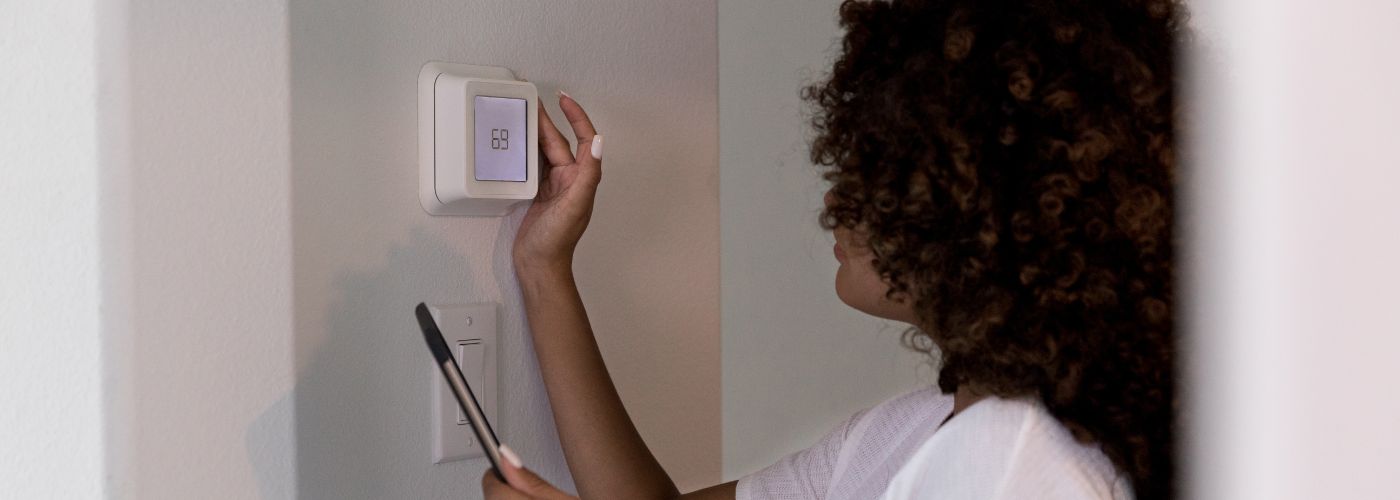In the rapidly advancing world of HVAC technology, the humble thermostat has undergone a remarkable transformation, and the spotlight is now on WiFi thermostats!
If you’re contemplating whether your home could benefit from this exciting upgrade, you’re in the right place. Read along as we take a look at WiFi thermostats, explore their advantages, address security concerns, and understand the difference between smart and WiFi thermostats!
What Is A Wifi Thermostat?
Before we jump into the benefits and considerations, let’s get acquainted with what a WiFi thermostat actually is.
In essence, a WiFi thermostat is a thermostat equipped with wireless connectivity, allowing it to connect to your home’s WiFi network. This connectivity enables you to control your home’s entire HVAC system remotely using a smartphone, tablet, or computer!
Why does that matter? Let’s take a look at what that means for the comfort and convenience of your residence.
Benefits Of A Wifi Thermostat
Remote Accessibility:
Picture this: you’re on your way home, and you want to ensure it’s the perfect temperature when you arrive. With a WiFi thermostat, you can adjust the settings from your smartphone, ensuring a warm welcome or a cool retreat, all from the palm of your hand.
Energy Efficiency:
WiFi thermostats empower you to optimize your energy usage. Create custom schedules, set temperature limits, and even receive energy usage reports! This level of control allows you to make informed decisions to enhance energy efficiency and reduce utility bills. If you’re searching for how to make your home colder without breaking the bank, a WiFi thermostat can be a fantastic solution!
Integration with Smart Home Systems:
Many WiFi thermostats seamlessly integrate with popular smart home platforms like Alexa, Google Assistant, or Apple HomeKit. This means you can incorporate your HVAC system into your broader smart home ecosystem, offering a cohesive and convenient home automation experience.
Smart Alerts and Notifications:
Stay informed about your HVAC system’s performance! WiFi thermostats can send alerts and notifications about maintenance reminders, filter replacements, and system malfunctions. This proactive approach to maintenance can extend the lifespan of your HVAC equipment.
Are Wifi Thermostats Secure?
Security is a top concern for any connected device, and WiFi thermostats are no exception. However, with the right precautions, they can be a secure addition to your home!
Always connect your WiFi thermostat to a secured, password-protected network. Avoid using default passwords and regularly update your WiFi password for an extra layer of security.
Keep your thermostat’s firmware up to date. Manufacturers often release updates to address security vulnerabilities and enhance performance. Regularly check for firmware updates and install them promptly.
If your WiFi thermostat offers two-factor authentication, it may be wise to enable it. This adds an extra layer of protection by requiring a verification code in addition to your password for access.
Perhaps most importantly, be sure to choose a reputable brand for your WiFi thermostat. Well-established manufacturers are more likely to prioritize security and provide ongoing support for their products. A trusted HVAC contractor may be able to recommend top picks for keeping your home both comfortable and secure.
Smart Thermostat VS Wifi Thermostat
While the terms “smart” and “WiFi” thermostats are often used interchangeably, they have nuanced differences. Understanding these distinctions can help you make an informed choice for your home:
WiFi Thermostat:
A WiFi thermostat focuses on remote accessibility and connectivity, allowing you to control your HVAC system from anywhere with an internet connection. While WiFi thermostats will frequently provide energy efficiency features and integration with smart home platforms, they’re generally more affordable than smart thermostats.
Smart Thermostat:
On the other hand, a smart thermostat offers advanced features beyond remote control, such as learning capabilities and adaptive programming. These may have the capability to learn your preferences over time, automatically adjusting settings for optimal comfort and efficiency.
It should be noted that although some may have compatibility with a wider range of smart home devices, smart thermostats can potentially be more expensive than WiFi thermostats.
With the ability to enhance energy efficiency, provide remote accessibility, and integrate with your smart home, a WiFi thermostat can be a valuable addition to your home comfort arsenal. Just remember to prioritize security measures and explore the features that align with your unique needs. Optimize your home comfort today with the power of WiFi thermostats!
